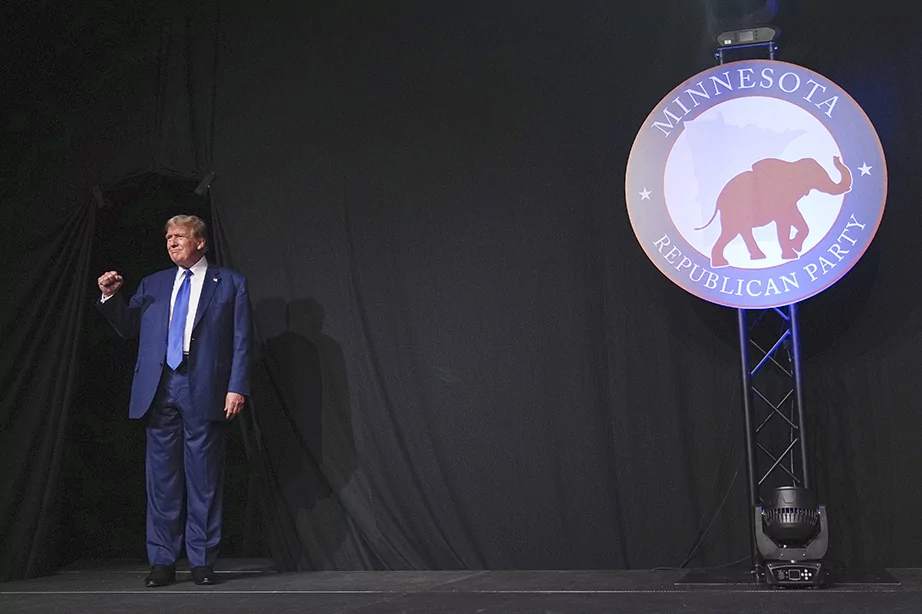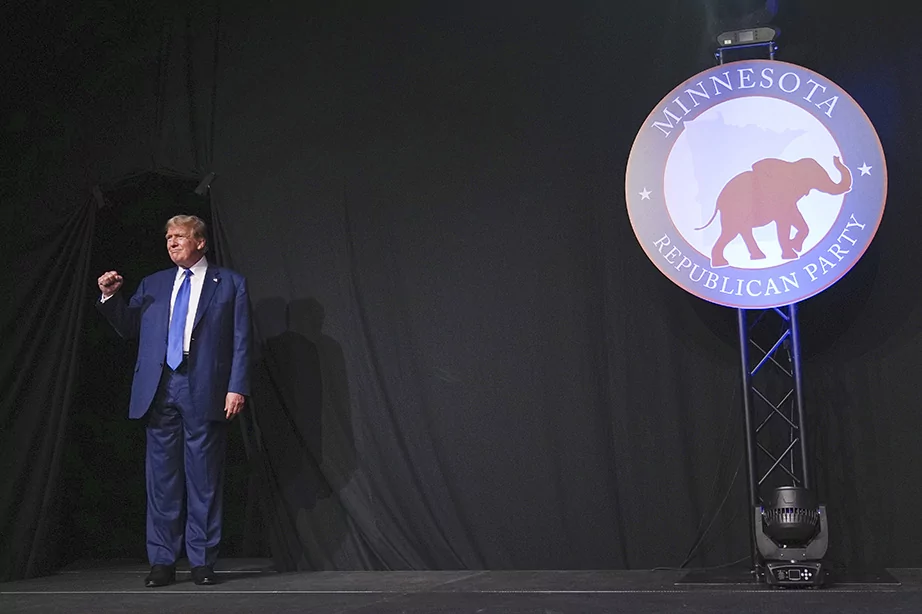
HOUSTON — A pair of decades-old MLB teams that have never won a World Series lead their divisions. The Seattle Mariners hold first place in the American League West, and the Milwaukee Brewers are out front in the National League Central. While the Cleveland Guardians, which last won a World Series in 1948, lead the American League Central.
Their stellar on-the-field performances, so far this season, are a reminder that even most moribund teams can come back and win. It’s similar in politics, where nothing is static. The halls of Congress are filled with lawmakers who lost previous races but persevered and made it into high office. Even President Joe Biden didn’t win the White House until his third try, in 2020, after failed efforts stretching back to 1988 and then 2008.
Still, at least this year, the maxim is likely to play out more on the baseball diamond than the presidential race, between Biden and former President Donald Trump, the incumbent’s vanquished 2020 Republican rival. In a politically divided nation, both sides agree that winning an Electoral College majority, 270 or more votes, comes down to Arizona, Georgia, Michigan, Nevada, Pennsylvania, and Wisconsin. Democrats are eying North Carolina, which former President Barack Obama won in 2008 but has since returned to its GOP voting ways. And New Hampshire is appealing for Republicans, where party members hold the Granite State’s governorship and both legislative chambers.
That’s where “reach” states come in. Those thought to be safely in one camp but, under the right circumstances, could flip.
For Democrats, it’s Texas, the behemoth, second-most-populous state in the nation, which has 40 electoral votes. Realistically, each baseball club now in first place stands a better chance of breaking its World Series championship drought than Democrats do of winning Texas in the 2024 presidential race. Virtually no serious analysts think Biden will be able to topple Trump in the Lone Star State, which has backed Republican nominees from 1980 on.
Still, recent shrinking margins of victory by GOP presidential candidates and some reasonably close calls in statewide races must make Democrats at least give Texas a second glance in their Electoral College math. A closely watched Senate race featuring a political figure reviled by Democrats, Sen. Ted Cruz (R-TX) could help boost turnout significantly. And there’s even a baseball analogy they can cling to. The Texas Rangers are the reigning 2023 World Series champions, their first title in more than half a century of play in Arlington.
For Republicans, the top reach target is Minnesota. A shift to Trump in the upper Midwest state would almost certainly reflect an overall poor performance by Biden and mean likely victory by the Republican ticket. The Biden campaign and Minnesota Democrats, known as the Democratic-Farmer-Labor Party, are likely to keep a close watch on Trump’s poll movement there over the next four months-plus until Election Day.
Texas Hold ‘em on Democratic campaign spending
Texas, home to more than 30 million people, is a huge political prize. Democrats have long had their eye on flipping the state.

“During the 2020 presidential campaign, Democrats had visions of winning Texas for the first time since 1976; polls between Biden and Trump were often close, and a few actually had Biden narrowly ahead,” the 2024 Almanac of American Politics noted. “Ultimately, Trump won the state again, but his margin shrank from nine points in 2016 to about five-and-a-half points in 2020.”
Democratic growth in the Texas presidential vote reflected the party’s suburban gain nationwide, with swaths of professional-class workers repelled by Trump.
“In addition to holding increasingly diverse Fort Bend County near Houston, which [2016 Democratic nominee Hillary] Clinton had flipped in 2016, Biden achieved some flips of his own by making doubt-digit gains in Tarrant County (Fort Worth) and Williamson and Hays counties in the Austin suburbs,” added the Almanac of American Politics. “Biden also narrowed Trump’s winning margin to single digits in Denton and Collin counties near Dallas-Fort Worth.”
Biden has been to Texas three times in 2024. That’s the same as California, the blue giant. But also, North Carolina Democrats have for years tried to turn into a genuine swing state.
But Democratic victory in Texas this year is wishful thinking, said Matt Mackowiak, a GOP consultant based in the state capital of Austin and chairman of the Travis County Republican Party.
“I don’t see any evidence of it whatsoever,” Mackowiak said in an interview. “The problem with Texas is it involves a massive investment.”
Texas has 20 media markets, Mackowiak added, ranging from smallish ones such as Beaumont-Port Arthur in the state’s far-eastern end to the major metropolitan areas of Houston and Dallas-Fort Worth.
“You could burn through $10 million quickly, just on TV ads,” Mackowiak said, adding that Democratic money would be better spent in real battleground states. “I’d be absolutely shocked if Democrats invest anything seriously here in the presidential race.”
One variable, though, is the Senate race. Cruz, first elected in 2012, faces Rep. Colin Allred (D-TX), who represents the northern Dallas 32nd Congressional District.
Allred is a former NFL linebacker who became a civil rights attorney and then beat an incumbent Republican House member in 2018. Cruz in 2018 won a closer-than-usual Senate reelection race over then-Rep. Beto O’Rourke, a Democrat from El Paso. In theory, strong voter turnout for Allred could boost Biden at the top of the ticket.
“The Cruz campaign is clearly conscious of the senator’s close call last time around, and is in the midst of attempting something of a brand pivot from disruptive bomb thrower to prudent bipartisan lawmaker,” Jim Henson and Joshua Blank, who lead the Texas Politics Project at the University of Texas, Austin, wrote in May.
Trump’s Minnesota not-so-nice approach
While Democrats are careful about openly talking up their chances in Texas, Republicans generally happily discuss efforts to win their top “reach” state, Minnesota.

Minnesota hasn’t voted for a Republican presidential candidate since Richard Nixon in 1972. Biden beat Trump in Minnesota by more than 7 percentage points in 2020. Yet in 2016, Trump came within 1.5 points of beating Hillary Clinton in the state.
“Trump’s narrow loss in Minnesota 2016 seemed to pose an existential threat for the DFL, as a half-dozen predominantly rural counties shifted their margins toward the GOP by between 20 and 36 percentage points,” the Almanac of American Politics noted. “But the DFL’s salvation was its continued edge in the Twin Cities region, which offered Minnesota more Democratic-leaning urban and suburban voters than neighboring states such as Iowa or Wisconsin.”
Whether Trump’s pugilistic style will sell statewide in Minnesota this year is an open question. “Minnesota Nice” is, after all, more cliche than reality, at least in political campaigns. The Gopher State has seen plenty of rough-and-tumble election fights, at least in the earlier part of this century when it was a genuine two-party state rather than leaning Democratic, as it does now.
Trump is taking a hard look at Minnesota for 2024, or so he says. On May 17, Trump used a day off from his Manhattan hush money trial, which ended in criminal convictions for him on 34 counts, to headline a Republican fundraiser in Minnesota.
Per the Associated Press, “Trump boasted that the steep tariffs he imposed on foreign steel while serving as president bought the Iron Range, the iron mining area of northeastern Minnesota, ‘roaring back to life.’ The area, with a heavy population of blue-collar workers and union workers, used to be solidly Democratic, but the region has been trending Republican in recent elections.”
A Star Tribune/MPR News/KARE 11 Minnesota poll released on June 10 found Biden narrowly leading Trump, 45% to 41%, in the Land of 10,000 Lakes, while independent candidate Robert F. Kennedy Jr. pulled in 6%.
University of Minnesota political science professor Larry Jacobs said Trump could be competitive against Biden in Minnesota.
“I think it’s quite possible. After all, 2016 was a close race,” Jacobs said in an interview. “And 2020 was an incumbent and on the defensive. Now in 2024, Biden is on the defensive.”
“Minnesota is a polka-dotted state,” added Jacobs, also director of the Center for the Study of Politics and Governance. “There are parts of the state that are extremely conservative.”
Adding to Biden’s campaign headaches, the Minnesota DFL is, like the national Democratic Party, divided over Israel’s defensive war against Hamas in Gaza in response to the Oct. 7 attacks.
“Will the DFL base turn out?” he asked. “We’re seeing some of the same patterns — the turnoff of youth. Minnesota has one of the highest proportions of ‘uncommitted’ vote during the Democratic presidential primary,” with many opting for that rather than vote for Biden.
Young people, Jacobs added, are “beyond furious with Biden with what’s going on in Gaza.”
If Minnesota starts to look seriously like it could tilt toward Trump, that’s got to be worrisome for the Biden campaign.
“Does Biden have to divert resources from states like Pennsylvania, Michigan, and Wisconsin to make sure they’ve got Minnesota nailed down? That would be a big sign of trouble,” Jacobs said.
Republican state Rep. Nolan West said in an interview it’s unclear how much of a shot Trump would have in his top “reach state.”
“It is a light-blue state, for sure. Still, Republicans have won here many times,” said West, whose constituency covers the northern Twin Cities metropolitan area. “I, for one, am very excited to hear we’re going to get national attention.”
CLICK HERE TO READ MORE FROM THE WASHINGTON EXAMINER
By the time presidential votes are tallied in Minnesota — and Texas and everywhere else in the nation — this year’s World Series will have recently concluded. Whether teams leading their rivals make it that far, let alone win, is very much an open question. They’re still more likely to come out on top than either Biden or Trump in their reach states.
But it’s not impossible. As sports fans often say about lopsided matchups, “That’s why they play the game.”







